Interviews with Past Winners
alab(Miri Ito / Kyoko Takahashi / Kao Muroya / Minato Yamanaka)
Word Block
2015 Grand Prix
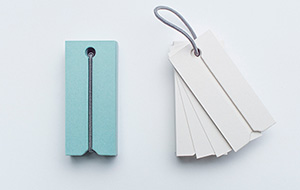
What kind of lifestyle can we propose for the future?
From the 1659 entries for the "Kokuyo Design Award 2015" held with the theme of "Beautiful Lifestyle" the one piece of artwork that achieved the top position was the "Word Block". Things surrounding us in our daily lives are being replaced by digital items but the one thing that we can believe will continue to exist in analogue form in the future would be the Word Block, word cards which we write by hand and are only for our own use. Focusing on the Word Block and in connection with this new proposal, we interviewed the 4 members of "alab".
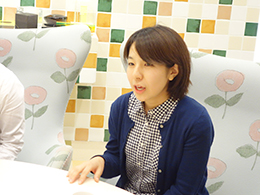
―― Can you tell us the background to how you came up with the idea for the "Word Block"?
Takahashi: "We were wondering how to interpret the abstract theme of "Beautiful Lifestyle" and went to the Kokuyo Design Award talk show. After that, the four of us talked together. We talked about such things as "a lifestyle when we are pressed for time is not beautiful" and "the moment when you step on a cut fingernail that has fallen on the floor is not beautiful" (laughs). First of all we began to think about different things, from small matters to big matters, and after sharing our ideas with each other we began to think. On the other hand, reflecting on our experience with "NEXT QUALITY", at that time it was a struggle to take the plunge into actually making something after deciding the concept completely. So this time we decided to actually make something concrete at the same time as thinking about how to interpret the concept of a beautiful lifestyle.
Muroya: Each of us thought about the theme, shared our ideas for things and repeatedly held discussions together. Initially, we had various ideas such as sticky notes and objects in our immediate surroundings.
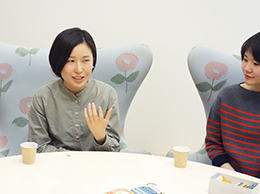
Ito: After that, we went to the stationery store to try to think objectively and there were sticky notes of various designs in the sticky-note section of the shop. And word cards were almost forgotten in a corner there and we felt that the gap was in the design and this led us to the Word Block.
Takahashi: When I thought about my own experience, I thought how much I disliked it when my stack of word cards came apart, got creased or dirty inside my bag and even if I put it in a box the ring would get in the way and it couldn't be put away properly.
Yamanaka: While we were all thinking together, the idea that it would be good if the rings themselves could function as bands began to take shape. If color was used in the paper, it would be easy to organize the word cards by selectively using each different colored paper.
―― How did you get the idea to take shape?
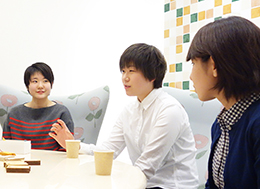
Muroya: The idea that we have in our mind and the real thing that we have in front of us are completely different. When there is no actual three-dimensional object we can't judge whether the usability is good or bad so we made lots of trial Word Blocks, in the stage before they became the Word Block, as well. The policy of our research laboratory was exactly like that.
Takahashi: We made the prototype for the Word Block by cutting wood with a laser cutter, so we had to verify the thickness and the shape of the groove to hook the rubber band into. The way that the band is hooked and how easy it is to remove are functions that always have to be used when using the Word Block, so we took most care over these points. We looked around for the fasteners and went to accessory shops and tried out various fittings. So actually we struggled the hardest during this part.
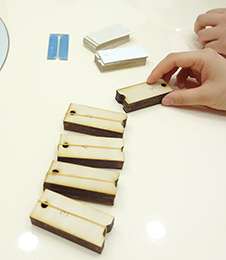
Ito: We gradually made some small changes to details so that, for example, the rubber band didn't come away from the cover, and brought the artwork to completion.
Yamanaka: We definitely wanted to avoid the original concept being lost through the item not being easy to use. If something is not easy to use then we feel that it is not beautiful in the first place. When the prototype had taken form to a certain extent, we made presentations to family and friends from our research laboratory and got some objective opinions. Including the prototype, we raised the quality of all the points that were connected to communication of the concept.
―― What kind of ideas did you use in your strategy for the preliminary selection presentation?
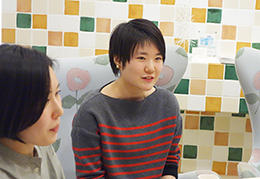
Yamanaka: I was in charge of graphic design for "alab" but there was a template for the presentation sheet so I wanted to convey the impression of the artwork at the same time as keeping to the template. The members of the selection panel look through thousands of presentation sheets so we didn't want them to get bored with ours and we didn't want them to think, "Oh here comes another one, just the same." At the same time as fitting the work into a template, we wanted it to break out of that fixed framework as much as possible. Since we are unable to show a model at the preliminary screening, we used a red rubber band in the presentation sheet for emphasis. We thought of doing it this way because last time this is the point on which we failed. In the previous competition we pushed what we ourselves wanted to make and failed so this time we thought quite a lot about how to communicate our concept.
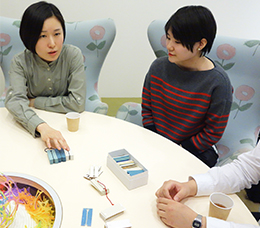
Ito: In the photos, I think it is important to show the scene where you are using the item rather than just showing the item by itself, so we used photos that include hands in the shots. We had the same way of thinking for the video we used in the final presentation, too.
Takahashi: We practiced many times and we continued to work on and improve our presentation using a video right up until the last minute. We faced our presentation head-on with the feeling that we just had to do what had to be done.
―― Please can you give some advice to people who are thinking of entering the Kokuyo Design Award competition from now on.
Takahashi: This time, I think that it was good to keep thinking while making something. Even if we could not all agree on our interpretation of the theme, the thing that you make whilst thinking at the same time can be linked to the theme. Finally, we interpreted "Beautiful Lifestyle" as "keep on learning forever". In the talk show that the four of us went to see at the beginning, the words "future lifestyle" came up many times so we realized that it wasn't good enough just to make a proposal for an item, and we kept on thinking about what kind of future lifestyle we could propose. So, I felt really happy hearing the words from the judges, "you were able to directly experience how tools change our lifestyle." A strength of joining such a team is that the amount of ideas are multiplied by four. Each time we proceeded by starting with the first word that we brought with us and catching on to the tail-end of an idea.
Ito: It took a lot of time but as there was never a single thing wasted, I decided not to begrudge the time. As I had never at all had such an experience before of thinking of a concept, then creating one thing, and finally communicating something, that alone was a great experience for me.
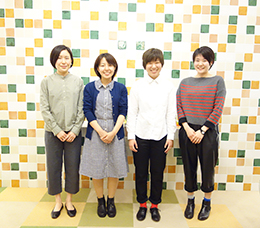
Muroya: If two people have different opinions and disagree, the other two people can listen objectively and give their opinions and I think this is the benefit of having four people in the group.
Yamanaka: Halfway through, our opinions were so different that they were the completely opposite to each other but in such cases we managed to find some points on which we could make a compromise. Now each one of the four of us are doing different jobs but as we feel that our activities with "alab" have a different meaning compared to work, we think that we want to continue our activities from now on as well.

























